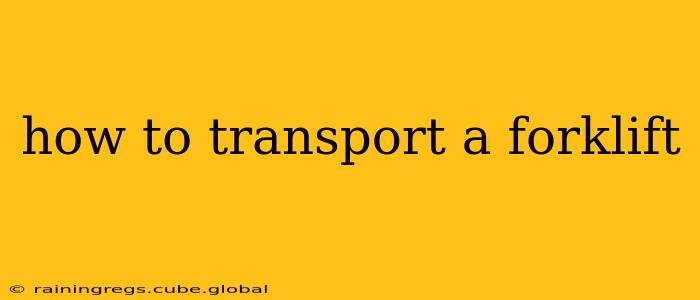Transporting a forklift, whether a small, electric model or a large, heavy-duty machine, requires careful planning and execution to ensure safety and compliance with regulations. This guide covers various methods, legal considerations, and safety precautions to help you move your forklift efficiently and responsibly.
What are the Different Ways to Transport a Forklift?
Several methods exist for transporting forklifts, each suited to different distances, forklift sizes, and budget constraints.
1. Driving the Forklift:
This is the simplest method for short distances and if the forklift is road-legal and the operator is properly licensed. However, it’s unsuitable for long journeys and may be restricted by local regulations.
2. Trailer Transport:
For longer distances, transporting a forklift on a trailer is a common and safe option. This can be done using a flatbed trailer, gooseneck trailer, or even a specialized forklift trailer. Securing the forklift properly is crucial to prevent movement during transit.
3. Roll-on/Roll-off (RoRo) Shipping:
For overseas or long-distance transport, RoRo shipping offers a cost-effective solution. The forklift is driven onto a specialized vessel, secured, and transported across water.
4. Container Shipping:
This method is suitable for both short and long-distance transport, offering greater protection against weather and theft. The forklift is loaded into a shipping container, properly secured, and shipped to its destination.
5. Specialized Heavy-Haul Transport:
For extremely large or heavy forklifts, specialized heavy-haul transport companies are necessary. These companies possess the expertise and equipment to safely move oversized loads, including the necessary permits and escorts.
How to Secure a Forklift During Transport?
Regardless of the chosen transport method, securement is paramount. Improperly secured forklifts can cause significant damage or accidents. Here’s what to consider:
- Use appropriate tie-down straps: Use high-quality, heavy-duty straps rated for the forklift's weight. Ensure straps are correctly tensioned and evenly distributed to prevent shifting.
- Consider the forklift's center of gravity: Secure the forklift to prevent it from tipping or shifting during transport.
- Use wheel chocks (if applicable): Wheel chocks help prevent the forklift from rolling on a trailer.
- Follow manufacturer's guidelines: Consult your forklift’s manual for specific recommendations on securement.
- Inspect before transport: Before beginning transport, carefully inspect the forklift and its securing system to ensure everything is in place and safe.
What Permits and Regulations Govern Forklift Transportation?
Transporting a forklift is subject to various regulations depending on the location, the size and weight of the forklift, and the mode of transport. These regulations often include:
- Oversized load permits: May be needed for forklifts exceeding standard size and weight limits.
- Driver's license requirements: Operators must hold appropriate licenses to drive a forklift on public roads.
- Vehicle registration and insurance: Ensure the transport vehicle is properly registered and insured.
- DOT regulations (for US transport): Adherence to Department of Transportation rules for securing cargo is essential.
What are the Costs Involved in Forklift Transportation?
The cost of forklift transport varies significantly depending on:
- Distance: Longer distances naturally cost more.
- Method of transport: Specialized transport methods, such as heavy-haul, are more expensive than simpler methods.
- Forklift size and weight: Larger and heavier forklifts require more resources, increasing the cost.
- Insurance and permits: Additional fees for permits and insurance are common.
Is it Cheaper to Transport a Forklift Myself or Hire a Professional?
While DIY transport might seem cheaper initially, professional services offer crucial advantages:
- Safety: Professionals have the expertise and equipment to transport forklifts safely and legally.
- Insurance and liability: Professional transporters carry insurance covering potential damages or accidents.
- Compliance: They handle all necessary permits and documentation, ensuring compliance with regulations.
- Efficiency: Professionals can transport the forklift efficiently, minimizing delays and downtime.
By carefully considering these factors and planning accordingly, you can ensure a smooth and safe forklift transportation process, minimizing risks and costs. Always prioritize safety and compliance with relevant regulations.
